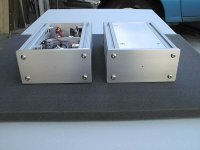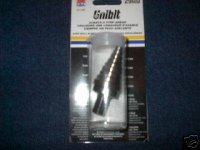I just finished my GC monoblocks. I didn't think I'd ever get done. I spent most of the time on the case. The boards were a piece of cake.
I used Brian's basic kit. I think is sounds very good. I'm not an audiophile, just a person who likes good sounding music and knows what sounds good (to me at least). My muscical tastes vary from film scores to jazz, from classical to punk (uh, don't like the rap though. I'm a white boy and just don't get it and thinks it all sounds the same).
My GC's are dead quite and don't even get warm. I do get a very, very slight tick when turning off the switch, but you can only hear it when you're ear is right next to the speaker.
Kudos to Brian and Peter for this kit together.
Here are some more images: http://f1.pg.photos.yahoo.com/ph/ken_cline/album?.dir=/5008&.src=ph
-Ken
I used Brian's basic kit. I think is sounds very good. I'm not an audiophile, just a person who likes good sounding music and knows what sounds good (to me at least). My muscical tastes vary from film scores to jazz, from classical to punk (uh, don't like the rap though. I'm a white boy and just don't get it and thinks it all sounds the same).
My GC's are dead quite and don't even get warm. I do get a very, very slight tick when turning off the switch, but you can only hear it when you're ear is right next to the speaker.
Kudos to Brian and Peter for this kit together.
Here are some more images: http://f1.pg.photos.yahoo.com/ph/ken_cline/album?.dir=/5008&.src=ph
-Ken
Attachments
Hello Ken,
Looks like you had lots of fun building you GC and can now enjoy the music and great looks
One thing I dont understand is why you used that red coax like piece of cable for the channel input. The braid (screen) acts like a capacitor and deadens the sound, just like those coax like interconnects and speaker cables.... Its all about compromise, and I think you could eliminate that one
Use plain untwisted wire (single solid core wire preferably) you may not notice, but it is better sounding.
And now, lets all enjoy the music
Regards,
Hugo
Looks like you had lots of fun building you GC and can now enjoy the music and great looks
One thing I dont understand is why you used that red coax like piece of cable for the channel input. The braid (screen) acts like a capacitor and deadens the sound, just like those coax like interconnects and speaker cables.... Its all about compromise, and I think you could eliminate that one
Use plain untwisted wire (single solid core wire preferably) you may not notice, but it is better sounding.
And now, lets all enjoy the music
Regards,
Hugo
electropt said:One thing I dont understand is why you used that red coax like piece of cable for the channel input. The braid (screen) acts like a capacitor and deadens the sound, just like those coax like interconnects and speaker cables.... Its all about compromise, and I think you could eliminate that one
Use plain untwisted wire (single solid core wire preferably) you may not notice, but it is better sounding.
First of all, nice work, Ken!
Interesting-looking binding posts too.
Hugo, I previously assumed that a screened input cable (e.g. microphone cable) helps prevent RF from being picked up. Does what you are saying apply to using the braid as a shield (i.e. 2-core cable), or as the ground/return (single-core cable)?
Cheers!
Thanks Guys,
Hugo,
I thought about trying a different input cable, but I got zero noise and it sounded fine to me. This cable in question is Canare LV-61S, which has a capacitance of 21pF per ft.
One question though, if this internal input cable is just an extension of the interconnect, how much of a difference could there be on the sound?
Diar,
One word...Unibit. I suggest everyone get one of these, they are great! (see the attached image)
One thing I dont understand is why you used that red coax like piece of cable for the channel input. The braid (screen) acts like a capacitor and deadens the sound, just like those coax like interconnects and speaker cables.... Its all about compromise, and I think you could eliminate that one
Use plain untwisted wire (single solid core wire preferably) you may not notice, but it is better sounding.
Hugo,
I thought about trying a different input cable, but I got zero noise and it sounded fine to me. This cable in question is Canare LV-61S, which has a capacitance of 21pF per ft.
One question though, if this internal input cable is just an extension of the interconnect, how much of a difference could there be on the sound?
What kind of tools do you guys use to make such big holes to aluminum sheets?
Diar,
One word...Unibit. I suggest everyone get one of these, they are great! (see the attached image)
Attachments
falcott said:
Hugo, I previously assumed that a screened input cable (e.g. microphone cable) helps prevent RF from being picked up. Does what you are saying apply to using the braid as a shield (i.e. 2-core cable), or as the ground/return (single-core cable)?
Cheers!
Indeed it does but since he has it in an aluminium case there is no need for that braided cable. The RF he could pick up inside the case would be a problem to the whole circuit, not just the input.
If you use the braid as RF shield you have to ground it. So the capacitance problem remains the same as in ground/return configuration.
RF problems tend to be the least of all your trouble in audio, unless you have a antena like system
You cannot say the same about highly capacitive cables...
Try to make a solid core (cat 5 for example) DNM style like interconnect cable. Use 3 untwisted wires, one for L one for R and one for comon ground. If you try it be aware that since this IC doesnt add anything to the music you may start to think your amp is not that good
kec said:
Hugo,
I thought about trying a different input cable, but I got zero noise and it sounded fine to me. This cable in question is Canare LV-61S, which has a capacitance of 21pF per ft.
One question though, if this internal input cable is just an extension of the interconnect, how much of a difference could there be on the sound?
I was aspecting that you would say something about the size... And in fact it does matter

If you used 15cm (1/2 ft) you have about 10pf to start with. My point is not about if it is 10pf 11pf or even 100pf, my point is the ideia behing your thinking is not the best implementation possible. Nor is mine for that matter... But I think is better
As the best possible wire is the "no wire", the best connection is the "no connection"
And remember I said "the best aproach to the problem" not the most practical
About the sound... I could only garanty that your system would be more true to the source, and as I said to falcott you may even not like the sound, but at that point the problem would not be the the IC cable.
Bottom line, the higher the capacitance the more "easy listening" (the music sound all the same and boring) the sound gets and harder it becomes to the amp to deal with it. I get less transients and the music goes flat...
I went from the straight wire maestro IC to the el cheapo DNM clone and guess what?

Cheers
Attention Kec, this heatsink is too small ! You must lead the heat also to sides of this box !
What heat. I've run these for hours and there is absolutely no heat. It doesn't even get warm. Really!
-Ken
How is the heatsink plate attached t the rest of the chassis? I couldn't figure out from the pics.
Peter,
The AL angle is attached to the bottom AL plate via screws from beheath. The whole thing is AL.
-Ken
Very nicely done, BTW. Are those extrusions available normally?
Thanks Peter. I'm not sure about your area. We have several 80/20 dealers locally. The places I contacted were more than happy to sell them to the public. I don't see why you wouldn't be able to get them. Their website is http://www.8020.net
McMaster-Carr also sells some these extrusions. I don't think they have the 1" x 3" that I used for this particular case but they have other sizes.
Bosch and a few others also make this type of extrusion, but they usually cost more than the 80/20 stuff.
-Ken
- Status
- This old topic is closed. If you want to reopen this topic, contact a moderator using the "Report Post" button.
- Home
- Amplifiers
- Chip Amps
- Yet Another Finished BrianGT GC...Finally!!!


